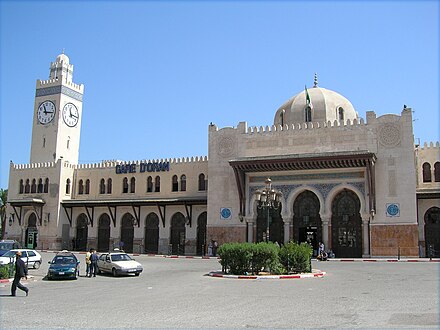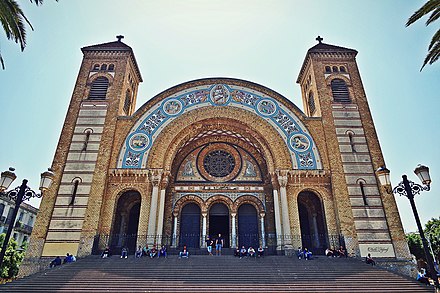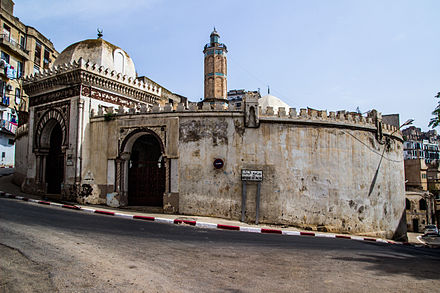Oran - city in Algeria
Oran is a city of more than 1,500,000 people in Northwest Algeria.
Understand

Oran's beautiful sea shore, constructed under French rule, was inspired by Nice's seafront. It consists of a long boulevard lined with cafés, restaurants, and ice cream shops. The boulevard also offers a splendid view of the sea, the harbour, Santa Cruz and the cliffs ("les Falaises"). It was renamed "Boulevard de l'ALN" by the government after the independence but it is still called Front de Mer by the locals.
History

Under French rule during the 19th and 20th centuries, Oran was the capital of a département of the same name. In July 1940, the British navy shelled French warships in the port after they refused a British ultimatum to surrender; this action was taken to ensure the fleet would not fall into German hands, as the Nazis had defeated France and occupied Paris. The Vichy government held Oran during World War II until its capture by the Allies in late 1942, during Operation Torch.
Before the Algerian War, 1954–1962, Oran had one of the highest proportions of Europeans of any city in North Africa. In July 1962, after a ceasefire and accords with France, a mob attacked European neighborhoods and massacred hundreds of Europeans in Oran, This triggered a larger exodus of Europeans to France, which was already underway. Shortly after the end of the war, most of the Europeans and Algerian Jews living in Oran fled to France. In less than three months, Oran lost about half its population.
Weather
Get in
By plane
- Ahmed Ben Bella Airport (IATA: ORN Es Sénia Airport), 35.627222°, -0.611389°. While not as large as Algiers' airport, it is still serviced by several international airlines.
- Air Algérie (Adrar, Algiers, Alicante, Annaba, Bechar, Brussels—Seasonal--, Casablanca, Constantine, Geneva, Hassi Messaoud, In Amenas, Jeddah, Lyon, Marseille, Paris-Orly, Ouargla, Toulouse)
- Air France (Paris CDG, Toulouse)
- Iberia (Madrid)
- Tassili Airlines (Algiers, Hassi R'mel)
- Transavia (Lyon, Montpellier, Nantes, Paris ORLY)
- Tunisair (Tunis)
- Turkish Airlines (Istanbul)
- Vueling (Barcelona)
- Volotea (Alicante, Barcelona)
By train

Oran is a major railway terminus with daily trains from most Algerian cities. Trains from the capital Algiers are plentiful, however, with several services daily. Other cities along the Mediterranean coast and in Northwest Algeria also has daily trains to Oran. Additional routes include an overnight train from Bechar, deep into the Sahara and about halfway from Mauritania. While there is a railway line continuing to Morocco, the border has been closed for decades due to political conflict.
All services are operated by SNTF (dead link: February 2023), timetables are published at their website.
- Oran Central railway station (Gare Centrale d'Oran), Rue Mankour Mahi Michel. All long-distance trains terminate here. 2020-11-19
By boat
One can also reach Oran by ferries from the ports of Marseilles as well as Alicante and Almería in Spain, via the national company Algérie Ferries or Trasmediterranea.
- Oran Ferry Terminal (Gare Maritime d'Oran), 35.7103°, -0.6466°. 2022-07-23
Get around
By foot
Walking is the obvious mode of transport within the city centre.
By bus
- 11 Which will take you from the east to west of the city. From Hai El Sabah to Place 1er Novembre
- 51 From USTO UNIVERSITY to M'Dina Jdida
- U From Senia UNIVERSITY to M'Dina Jdida
- P1 From City center (Lycée lotfi) to Canastel (ORAN EAST)
By metro
An underground metro network is under construction, the first line is expected to open in late 2022.
By tram
A single tram line runs from Es Sénia in the south to Bir El Djir in the northeast, via Place 1er Novembre. A single ticket is DA40 and can be bought at kiosks near the tram stops.
See


Oran has a very walkable historic city centre with a mix of Islamic and European buildings.
-
district of Sidi El Houari
-
municipal gardens
-
Djebel Murdjadjo
-
Santa Cruz Fort, 35.7093°, -0.6647°. Fortress on top of the hill overlooking Oran. 2022-07-24
-
Santa Cruz chapel (Chapelle de Santa Cruz). 2022-07-24
-
Sacred Heart Cathedral of Oran (Cathédrale du Sacré-Cœur d'Oran), Blvd Abderahmane Mira, 35.7002°, -0.6463°. Former Roman Catholic church, built in 1930. Now turned into a library. 2022-07-23
-
Hassan Pasha Mosque (مسجد حسن الباشا, Masjid Hassan El-bacha), 35.7044°, -0.6547°. A very ornate mosque, built in 1797. However, it is in a rather dilapidated state. 2022-07-23
-
Oran zoo (zoo d'Oran), 35.68930°, -0.64668°. Small zoo with animals such as lions, tigers and monkeys. Cage sizes would probably not pass any animal welfare inspections. DA100 and DA60 for children
-
Abdellah Ben Salem Mosque (مسجد عبد الله بن سلام), Boulevard Maata Mohamed El Habib. Completed in 1918, this is the former Great Synagogue of Oran. After Algerian independence, most Jewish citizens left the country. In 1975, the synagogue was converted into a mosque and named after Abdullah ibn Salam, a seventh-century Jew from Medina and companion of Muhammad who converted to Islam. 2022-07-21
-
Bey's Palace. 2022-07-23
Museums
- Ahmed Zabana National Museum, 19, Avenue Ahmed Zabana. Named after the Algerian resistance fighter Ahmed Zabana, the first floor of the museum tells the story of the local impact of Algeria's battle for independence from France including a list of local people executed by the French between 1954 and 1962. The museum also includes artwork in the form of ancient sculptures, some mosaics and terracotta portraits and paintings including works by 20th-century Algerian artists and French Orientalists including Eugene Fromentin. 2022-07-23
- Museum of Modern Art of Oran. 2022-07-24
Do
- Walk along the Corniche, 35.70605°, -0.63523°. Sidewalk with good views
Buy
Note: most shops and restaurants don't accept payments cards. As of February 2022, withdrawing money from an ATM of an Algerian bank also usually doesn't work. The ATMs of Gulf Bank 📍 will accept Visa and MasterCard.
- Le Marché de Medina Jedida with art products
- Es-Senia Shopping & Leisure Center (Es Senia Centre Commercial & De Loisirs), 35.6379°, -0.5905°. Large shopping mall.
Eat
Here are some popular places to eat
Budget
- Wifi Resto Club, 14 Boulevard Docteur Ban Zerdjeb, 35.69930°, -0.64744°, +213 41-399663. Sa-Th 11AM-10PM, closed Fridays. Pizzeria and other fast food, offers free WiFi.
Mid-range
- Le Royaume du Couscous, 15 Rue Ho Chi Minh, 35.70304°, -0.63886°. Many types of couscous as well as starters and desserts.
- Les Ambassadeurs, 1 Boulevard de la Soummam, 35.70325°, -0.64779°, +213 41-981000. Serves Mediterranean cuisine, located at the Royal Hotel.
- Restaurant le Corsaire, 09 République sidi el-Houari, Boulevard de L'A.L.N, 35.70325°, -0.64779°, +213 770 99 99 31. Located in the old town.
Splurge
Drink
Oran's nightlife is among the most thriving in the continent. The city has always been the capital of Algeria's parties and music. All night long, plenty of nightclubs, bars and cabarets are open and offer music, dance and partying in the city area seafront, called La Corniche, which runs from the city's Front de Mer to the neighbouring cities of Aïn El Turk, Bou Sfer and El Ançor. All kinds of nightclubs can be found, from the very posh Atmosphère at the Sheraton Hotel that attracts now international DJs such as David Vendetta to more popular ones in the Corniche, such as Les Pins d'Or, SunHouse and Le Murdjadjo.
Sleep
Budget
- Le Raja Hotel, 12 rue Arago Place des victoires, 35.701949°, -0.637314°, +213 41 331431.
- Sarl Hotel El-mansour, 7 Rue Ozanam (Near le Cathedrale), +213 41 295590. The best among budget hotels in the town. Friendly staff, clean, shared bathroom, hot shower, air conditioning. DA600
Mid-range
- Hotel Residence Le Timgad, 22 Bd Emir Abdelkader, +213 41 294797. A 4-star hotel in the centre of the town, free wifi, breakfast, nice and big room with western standard facility. the only small problem is the staff speak little English but very friendly, very good in French and Arabic. DA4600
- Hotel Colombe, 6 Boulevard Zabour Larbi (Southeast of the train station, near the cathedral as well as the Palace of Cultures), 35.692754°, -0.628158°, +213 41-466162, reservation@hotelcolombe.com.
- Le Meridien Oran Hotel & Convention Center, Les Genets, Chemin de Wilaya, Route 75, 35.726948°, -0.591792°, +213 41 984000. Situated on a high cliff with a stunning view over the Mediterranean Sea and the city centre of Oran. The hotel will form part of a larger complex including an adjacent conference and exhibition centre, and an oceanfront promenade.
Splurge
- Royal Hotel Oran, 1 Boulevard de la Soummam, 35.703330°, -0.647773°, +213 41-981000, contact@royalhoteloran.com. Luxorius hotel located in central Oran, not far from the docks. Often rated as great value for money.
- Sheraton Oran (Four Points by Sheraton), Boulevard du 19 Mars, Route des falaises, 35.71659°, -0.61062°, +213-41-590100, sheraton.oran@sheraton.com. One of the fanciest hotels in Oran with breathtaking views of the ocean from each room. The hotel also features a complimentary airport shuttle, restaurants and a tennis court. Prices start at DA14,250
Connect
Stay safe
Oran is considered a safe city. Just use some common sense: avoid wearing expensive jewellery or looking flashy, do not flash large quantities of cash, and avoid unfamiliar and deserted areas at night. If you walk in crowded streets or use a bus, keep a hand on your pockets. Women should avoid low-cut tops, midriffs, or shorts to avoid harassment (which almost always consists of comments, but nothing physical) although this is less of a problem than in other cities. Don't feel the need to be polite.
Cope
Diplomatic missions
If you run into any trouble, or if you need assistance of any kind, head over to Algiers.
| { |
|---|
| style="vertical-align:top;width:50%;" |
- 🇫🇷 France (French Consulate General in Oran, Algeria), 1 rue Aïmeur Brahim 31000, Oran, Algeria, afe.oran-cslt@diplomatie.gouv.fr. 2022-12-29
| { |
|---|
| style="vertical-align:top;width:50%;" |
- 🇪🇸 Spain (Spanish Consulate General in Oran), +213 41 33 21 65, cog.oran@maec.es. 2022-12-29
Go next
Oran
oran-dz.comOran
Primary administrative division